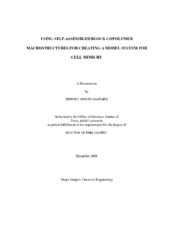| dc.description.abstract | The objective of this research is to investigate three classes of block copolymers, the vesicle structures they form, their response to stimuli in solution and their capabilities for use in biomimicry. The self-assembled structures of all classes of polymers will be used as a basis for templating hydrogel materials, in the interior of the vesicles, and the resulting particles will be designed to show the structural and mechanical properties similar to living cells.
The synthetic block copolymers are a poly(ethylene glycol) and poly(butadiene) (PEO-b-PBd) copolymer, a poly(ethylene glycol) and a poly(dimethyl siloxane) (PEO-b-PDMS) copolymer and the polypeptide block copolymer is a lysine and glycine (K-b-G) copolymer. Investigation using the synthetic block copolymers will focus on whether the polymer can form vesicles, size limitations of vesicle structures, and the formation of internal polymer networks. Subsequent investigations will look at the needed steps for biomimicry.
The PDMS copolymer is a novel entrant into amphiphilic block copolymers. Although characterization of the copolymer solution behavior is known, the mechanical properties of the polymer are not known. PDMS was investigated along with the PBd polymer due to the similar chemical structure and nature.
The lysine-glycine copolymers are a new system of materials that form fluid vesicle structures. Therefore, characterization of how K-b-G assembly behavior and investigations of how K-b-G responds to solution conditions are needed before incorporating this copolymer into a cellular mimic. The size and mechanical behavior of the lysine-glycine vesicles are measured to compare and contrast to the synthetic systems.
The goals in creating a biomimic are a hollow sphere structure with a fluid bilayer, a vesicle that has controllable mechanical properties, and with a controllable surface chemistry and density. Overall, these experiments were successful; the various properties are easily controllable: the size of vesicles created, the material properties of the vesicle interior and shell, as well as the surface chemistry of the vesicles.
Investigations into the novel block copolymers were conducted, and the polypeptide block copolymer showed the ability to create vesicles that are responsive to changing salt and pH concentrations. The PDMS block copolymer system offers a new material system that will perform as well as the PBd system, but without some of the inherent drawbacks. | en |


